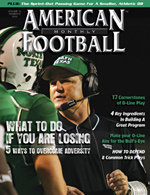Article CategoriesAFM Magazine
|
Coaching in Denmark Part IIIby: Wayne Anderson© More from this issue For my final and third installment on my coaching experience in Denmark, I would like to share two topics that are universal when it comes to coaching American football: officiating and game management. My wife and I were thrilled to attend the Steelers/Dolphins game on October 24 in Miami. As the clock ticked down to the final minutes, the game was suspended in air as Ben Roethlisberger’s touchdown attempt was being reviewed by the officials. Every fan, whether wearing black and gold or aqua and orange, remained standing in anticipation of the judgment call about to be handed down. Although the bizarre double ruling impacted each sideline differently, the final decision was in the hands of the men wearing the black and white striped shirts - the officials. At any level of foo....The full article can only be seen by subscribers.
|
|
|||||||
| HOME |
MAGAZINE |
SUBSCRIBE | ONLINE COLUMNISTS | COACHING VIDEOS |
Copyright 2025, AmericanFootballMonthly.com
All Rights Reserved





